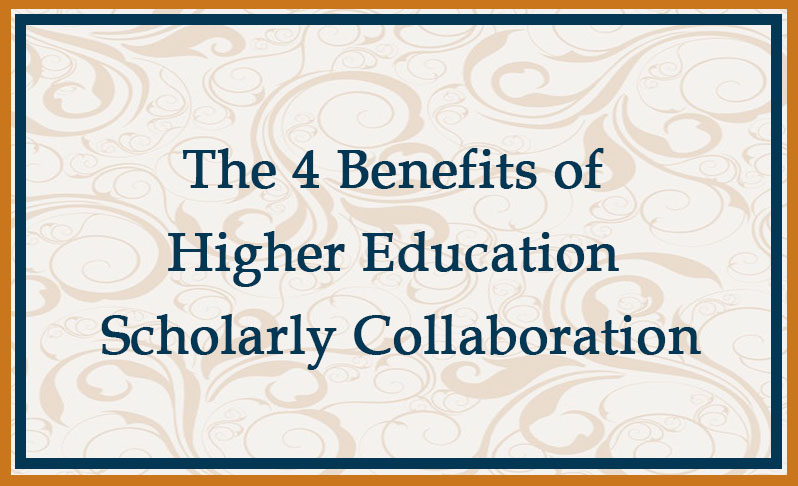An issue of the Chronicle of Higher Education (November 14, 2014) carries an essay that provides a rationale for the traditional role of the solitary scholar. In “Leave Me Alone,” Magdalena Kay laments the current trend toward collaborative writing in academia, arguing, “I believe the best work, particularly that dinosaur known as the single-author scholarly book or article, often gets done in solitude” (B20).
We beg to differ. Each of us began with single-authored pieces, but over the years we have come to recognize that collaboration has made us better writers. While our chief constellation involves a triad, we wrote Teaching Applied Creative Thinking (2013) as a quartet, and Hal and Charlie recently co-wrote Achieving Excellence in Teaching (2014) with two different members singing in their quartet (hey, even the Beatles changed drummers). I likewise have written with others, and recently the three of us partnered with two graduate students on an article about flipping the classroom.
Kay is right that while collaboration is becoming the norm in the hard and social sciences, the humanities still favor single authorship. The three of us came out of the traditional departments of English, but now like Whitman’s spider we constantly cast out filaments trying to connect with other writers. Why? For the long answer, check out It Works For Me, Collaboratively (2006), It Works For Me as a Scholar-Teacher (2008), It Works For Me: Becoming a Publishing Scholar/Researcher (2010), or our chapter on “Collaborating” in Introduction to Applied Creative Thinking (2012). Here, we’ll just suggest some short answers.
4 Benefits of Scholarly Collaboration
More ideas. In the old days we relied on our students, actual works of literature, and critical works to stimulate our brain cells. Now that we have transitioned into predominantly administrative roles, we find our colleagues aid us directly or indirectly in producing scholarship. Obvious, as the genesis of this piece proves, we still read the literature in the field, but we depend more on bouncing our ideas of each other. If two heads are better than one in brainstorming, what are three, four? We’ve seen the research on ideation levels improving from a single source to multiple sources an incredible 600%.
Better ideas. A major problem in single authorship is critical thinking. Book writers often have a pool of peers or an editor to guide them through the process. We learned more about writing from our former editor at Writer’s Digest than we did in graduate school. Other voices provide perspective, making us shift our commas and concepts.
Stimuli to persist. When one writes alone, it is too easy to succumb to distractions—checking the email, raiding the fridge, going for a walk—but the social-ability of writing with others means you’re stuck for the entire time period you’ve chosen to work on the task. And it’s more fun. Someone else can crack a joke, tell an anecdote, or provide that charge you need to continue when your mind is telling you a thousand other places you could be. Moreover, collaborators often provide that simple, enthusiastic “Hey, good idea” or “Atta-girl” that keeps you going better than Red Bull.
Compensate for your weaknesses. Charlie and Hal are not as technologically competent as Rusty. Rusty and Hal don’t follow pop culture as much as Charlie. Charlie and Rusty don’t understand absolute phrases and appositives as well as Hal (to this day Charlie never uses “lie” or “lay” without first consulting Hal). Charlie comes up with ideas well, Rusty synthesizes them better, and Hal organizes the thoughts best. And sometimes it takes all three of us to figure out the proper APA citation.
In the beginning we all write alone. The three of us wouldn’t have discovered the advantages and joy of collabo-writing had we not tried it. Is it for every scholar? Probably not, but you won’t know if you don’t give it a go.
Author
 Dr. Russell Carpenter is director of the Noel Studio for Academic Creativity and Program Director of the Minor in Applied Creative Thinking at Eastern Kentucky University. He is also Assistant Professor of English. Dr. Carpenter has published on the topic of creative thinking, among other areas, including two texts by New Forums Press. In addition, he has taught courses in creative thinking in EKU’s Minor in Applied Creative Thinking, which was featured in the New York Times in February 2014. Meet Russell.
Dr. Russell Carpenter is director of the Noel Studio for Academic Creativity and Program Director of the Minor in Applied Creative Thinking at Eastern Kentucky University. He is also Assistant Professor of English. Dr. Carpenter has published on the topic of creative thinking, among other areas, including two texts by New Forums Press. In addition, he has taught courses in creative thinking in EKU’s Minor in Applied Creative Thinking, which was featured in the New York Times in February 2014. Meet Russell.



